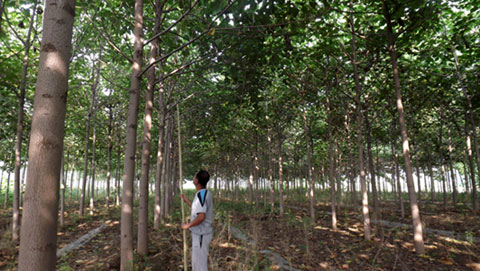Tending Management of Paulownia Afforestation
Tending management for Paulownia artificial forest refers to various management and protection actualized after the plantation until harvest cutting. This is an essential part relating to success of afforestation.
During the period after the afforestation until surviving and growing into forest, trees will be affected by climate, soil, vegetation, animals and human behavior. When crowns closed, trees will be influenced by other individual plants and group plants as well. Therefore, careful tending management must be actualized for Paulownia artificial forests to make trees grow with higher survival rate, in fast and good manners and grow up into forest as early as possible by which realize the afforestation purpose. In order to achieve the purpose of fast-growing and high-yield, tending management must be strengthened for sapling forests after the afforestation process, especially those after afforestation of 3-4 years. The so-called saying of “One-third of afforestation and two-thirds of tending” is just going like this.

During the period after afforestation process until cutting, trees will pass through several developmental stages with different growth characteristics. On the aspect of tending management, relevant technical measures shall be adopted according to Paulownia species, site conditions and development features of different growth phases. There are four periods in the whole process of growth and development.
Sapling Period
Saplings of Paulownia are striking roots in this period whose growth of aboveground part is slow and gradually speeding up, which make it easy for them to be restricted by natural environment. Full development of the root system is the key factor for sapling forest of Paulownia. Therefore, helping sapling forests of Paulownia to overcome disadvantage factors brought by environment, enhancing protection for sapling forests and providing water, fertilizer, air, light and heat for sapling forests are the major tending management tasks in this period, which is also the period needing the most artificial investment.
Strong Period
This period is called the fast-growing period when sapling forests of Paulownia is growing faster especially on their height and coming into the vigorous phase. Tending management for this period shall meet requirements for height growth of Paulownia and promote the growing ability of Paulownia on height.
Mid-Age Period
After the fast-growing period, diameter growth of the trees continues to be exuberant while the height growth slows down. Crown expands rapidly with eager demand for more sunlight. Growth in Paulownia’s volume of timber also peaks along with vigorous diameter growth. Artificial tending management in this period shall provide enough sunlight and space for the forest, promote the diameter growth of Paulownia and shorten the cutting period.
Mature Period
In this period, growth in diameter and log volume has become slow; growth in height almost stops and conflict among trees of the forest has become moderate. Harvest cutting shall be utilized for this period and proper methods for forest regeneration shall be implemented.
